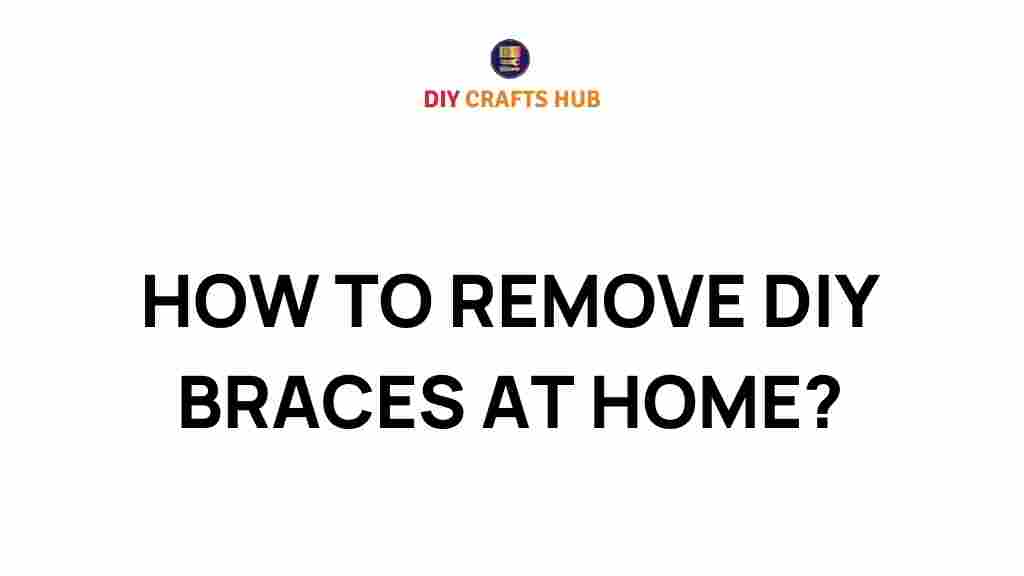Understanding DIY Braces: What You Need to Know
Over the past few years, DIY braces have gained popularity as a cost-effective alternative to professional orthodontic treatments. While they may seem like a quick fix, they come with risks. If you’ve used DIY braces and are considering removing them, it’s crucial to do so safely. In this guide, we’ll walk you through the steps of safely removing your DIY braces at home.
How to Safely Remove DIY Braces at Home
Removing DIY braces at home requires care, precision, and the right tools. Follow this step-by-step guide to ensure a safe removal process without causing damage to your teeth or gums.
Step 1: Gather the Necessary Tools
Before you start, ensure you have the following tools:
- Orthodontic wax
- Sterilized tweezers
- Dental mirror
- Floss or an interdental brush
- Dental pliers (if necessary)
- Disinfectant or antiseptic mouthwash
Make sure all tools are clean and sterilized to minimize the risk of infection.
Step 2: Prepare Your Mouth
Proper preparation is key to safe removal:
- Brush your teeth thoroughly to remove food particles and plaque.
- Rinse with antiseptic mouthwash to reduce bacteria in your mouth.
- Examine your DIY braces using a dental mirror to identify where they are attached.
Step 3: Begin the Removal Process
Follow these steps to safely remove the braces:
- Use the tweezers to gently disengage the elastic bands or ties securing the braces.
- If using adhesive, carefully detach the brackets with sterilized dental pliers.
- Proceed slowly and ensure there’s no excessive pressure on the teeth.
- Remove any remaining glue or residue with a soft dental scraper or floss.
Take breaks as needed to avoid discomfort or irritation.
Step 4: Clean and Care for Your Teeth
After the braces are removed, follow these steps:
- Brush your teeth gently with a soft-bristled toothbrush and fluoride toothpaste.
- Rinse thoroughly with antiseptic mouthwash.
- Use floss to clean between teeth and remove any remaining debris.
For additional information on post-braces care, check out our dental care tips.
Troubleshooting Common Issues
What If the Braces Don’t Come Off Easily?
If you experience difficulty removing your DIY braces, avoid forcing them off. This could damage your teeth or gums. Instead, consult with a licensed orthodontist for professional assistance.
Handling Discomfort or Pain
Some discomfort is normal during the removal process. Use orthodontic wax or over-the-counter pain relief to alleviate irritation. Persistent pain, however, should be addressed by a dental professional.
Dealing with Glue or Residue
Leftover adhesive can be gently scraped off with a dental tool or polished away by your dentist. Avoid using abrasive materials or excessive force.
The Risks of DIY Braces
While DIY braces might save money initially, they come with significant risks. Improper use can lead to:
- Tooth decay
- Gum infections
- Permanent misalignment
- Tooth loss
For a safer and more effective approach, consider professional orthodontic treatments. Learn more about the importance of proper dental care from the American Dental Association.
Conclusion
Removing DIY braces at home is possible, but it requires patience, the right tools, and a careful approach. Always prioritize your dental health by following safe practices and seeking professional advice if necessary. While DIY braces may offer a quick solution, investing in professional orthodontic care ensures long-term dental health and confidence in your smile.
If you’re exploring post-braces care, don’t forget to check our comprehensive dental care resources to keep your teeth healthy and strong.
This article is in the category DIY Tools and created by DIYCraft Team
